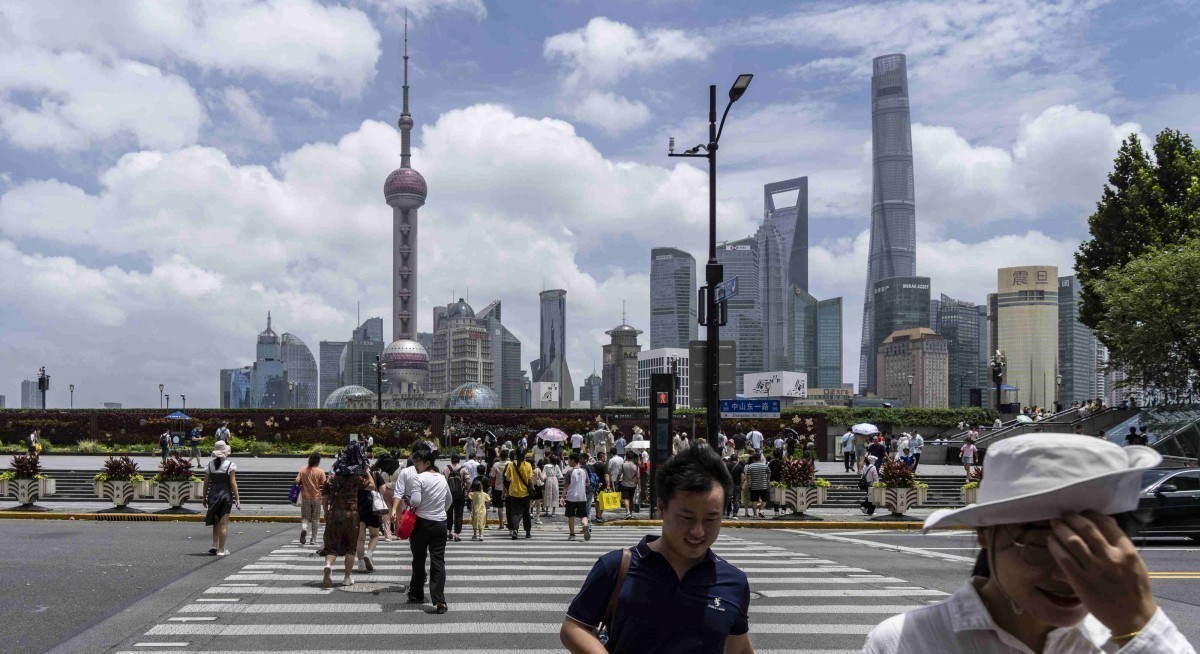Liao also hailed the latest Chinese GDP growth figures as helping to contribute to the world economy at a decisive moment. Economists have marked down their projections for global growth this year due to the onslaught of tariff increases by President Donald Trump. Figures this week showed China’s expansion at 5.3% for the first half of the year — “in line with expectations,” Liao said.
“China’s certainty and stability are the greatest contributions it makes to the world today, because what the global economy needs most right now is stability and certainty,” Liao said. “We are steadily advancing toward an economic model driven by consumption, while at the same time maintaining a relatively balanced foreign trade.”
The latest China GDP figures showed exports supported growth in the most recent quarter. The country logged a goods-trade surplus of about US$586 billion in the first half of the year — due in part to exporters front-loading shipments on tariff fears. While export momentum is expected to cool in coming months, some economists still see a record full-year surplus above US$1 trillion.
Liao highlighted that, over the past four years, consumption has driven an average of 56.2% of China’s GDP gains. That’s 8.6 percentage points higher than during 2016-2020 period, he said. Domestic demand as a whole accounted for 86.4% of China’s growth, the vice minister said.
See also: Shanghai sets up big commodities trading firm to boost influence
He also said China’s current-account surplus — the broadest measure of trade, as it includes services and some financial transactions — was about 2.2% last year, a level “recognized globally as reasonable” and indicating the share of its shipments worldwide is “not excessively high.”
China's Current-Account Surplus 'Reasonable,' Liao Says | China vice minister points to about 2% ratio for last year
See also: The coming China shocks
China’s critics have used other metrics. A top US Treasury official last year cited figures showing China’s manufacturing-goods trade surplus approaching 2% of world GDP, roughly twice the share of Japan’s in the early 1990s. Current Treasury Secretary Scott Bessent has repeatedly called China “the most imbalanced economy in the history of the world.”
Speaking at a congressional hearing last month, Bessent charged Beijing with “trying to export their way out” of the nation’s domestic real estate slump.
Liao’s comments come ahead of an expected fresh round of trade talks with the US in the coming weeks. He didn’t offer any specific comment on Bessent’s criticism in the interview Friday. The vice finance chief has been a key member of the country’s team of negotiators that reached a trade-war truce with their American counterparts in Geneva, and again in London, earlier this year.
Consumption aid
Liao also said that looking at a particular sector can give a flawed perspective of China’s trade.
“Just because China holds a large market share in certain products doesn’t mean it should be accused of overcapacity,” he said. “Such claims are oversimplifications and fail to capture the full reality.”
The huge uncertainty surrounding Trump’s levies on Chinese goods has added urgency in Beijing to shift its growth toward domestic consumption.
The government doubled the amount of ultra-long special sovereign bond issuance this year, aimed at subsidizing consumer purchases of electronic products, home appliances and cars. That took the total to 300 billion yuan (US$41.8 billion). More than half of the allowance was used in the first half, incentivizing sales of about 10 times that amount.
To stay ahead of Singapore and the region’s corporate and economic trends, click here for Latest Section
For the longer term, the authorities will seek to expand service industries and promote the green and digital sectors, with a goal of propelling economic transformation — beefing up consumer spending power as jobs and incomes rise, Liao said.
Meanwhile, the government will continue strengthening social safety nets, including pensions to ensure stable growth in consumer spending over the long run, he said.
Liao spoke with Bloomberg after the conclusion of the G-20 meeting of finance ministers and central bank chiefs that resulted in a joint communique. He hailed the adoption of that statement, saying it showcased the effectiveness of the group’s finance track, despite different viewpoints.
“It sends a strong message that countries are committed to better communication, closer coordination and working together in a spirit of unity,” Liao said, adding that China will continue to support multilateralism and the G-20.
“The G-20 itself was created as a platform for the international community to respond to crises. At a time when the global economy is facing so much uncertainty and so many challenges, the G-20 should play an even greater role,” Liao said.




